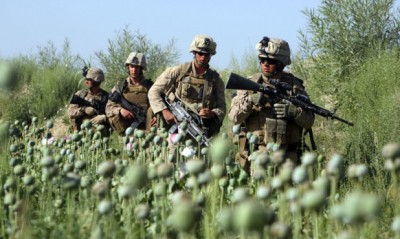Afghanistan and the Curse of Natural Resources: The Trump Administration Continues America’s Longest War

In a 2015 interview with CNN, Trump said that invading Afghanistan in 2001 was a “terrible mistake,” however, he maintained that U.S. troops would need to stay because the Afghan government would collapse. He did say that “we made a terrible mistake getting involved there in the first place,” and that “it’s a mess, it’s a mess and at this point we probably have to (leave U.S. troops in Afghanistan) because that thing will collapse in about two seconds after they leave.” in 2013, Trump’s tone on the war in Afghanistan was different according to his 2013 twitter post:
“Do not allow our very stupid leaders to sign a deal that keeps us in Afghanistan through 2024-with all costs by U.S.A. MAKE AMERICA GREAT!”
U.S. President Donald Trump will continue what the Bush administration had started after the September 11th attacks in 2001 and where the Obama administration left off, and that is to continue America’s longest war in Afghanistan. Trump has authorized the Secretary of Defense James “Mad Dog” Mattis to decide what troop levels is needed to defeat the Taliban. Reuters‘ reported that
“The decision is similar to one announced in April that applied to U.S. troop levels in Iraq and Syria, and came as Mattis warned Congress the U.S.-backed Afghan forces were not beating the Taliban despite more than 15 years of war.”
Mattis went on to mention that
“We are not winning in Afghanistan right now,” Mattis said in testimony to the Senate Armed Services Committee last week. “And we will correct this as soon as possible.”
It’s obvious that the U.S. war machine is not winning the war, besides it only took Washington 15 years to realize that reality. Since 2001, more than 2,300 U.S. troops have been killed in action and more than 17,000 wounded. The Reuter’s report also mentioned the chairman of the Armed Forces Committee and war hawk, Senator John McCain, who questioned General Mattis on the volatile situation in Afghanistan during the hearing said that the United States needs “a change in strategy, and an increase in resources if we are to turn the situation around.” Mattis acknowledged McCain and said that “we recognize the need for urgency.” The New York Times reported that the
“Pentagon is moving ahead with plans to send 3,000 to 5,000 troops to try to stabilize the country.”

Former President of Afghanistan Hamid Karzai with Former US President Barack Obama on Bilateral Security Agreement (Source: The Daily Afghanistan Express)
On September 30th, 2014, Washington and Kabul signed a Bilateral Security Agreement (BSA) under which so. me 10,000 U.S. troops can remain in Afghanistan after the international combat mission ” that was supposed to end on December 31st (which of course it did not end under the Obama administration). The BSA goes went into effect on January 1, 2015 and will remain until “the end of 2024 and beyond” unless it is terminated by either side with two years’ notice. The word “beyond” signifies that U.S. troops will stay in Afghanistan forever (or for as long as the U.S. remains an empire in search of natural resources which is the case since Afghanistan has lead, barites, coal, copper, talc, , sulfur, zinc, iron ore, salt, petroleum, precious and semiprecious stones, arable land, natural gas and of course plenty of opium for the growing U.S. market of heroin users. In a 2010 article published by The New York Times, senior U.S. officials discovered an abundance of mineral deposits and other natural resources of than can change the course of the war in Afghanistan meaning that U.S. troops would remain indefinitely or until the natural resources run dry:
The United States has discovered nearly $1 trillion in untapped mineral deposits in Afghanistan, far beyond any previously known reserves and enough to fundamentally alter the Afghan economy and perhaps the Afghan war itself, according to senior American government officials.
The previously unknown deposits — including huge veins of iron, copper, cobalt, gold and critical industrial metals like lithium — are so big and include so many minerals that are essential to modern industry that Afghanistan could eventually be transformed into one of the most important mining centers in the world, the United States officials believe
Last April, The Associated Press published a report ‘Afghanistan Dangles Lithium Wealth to Win Trump support’ and said:
The Afghan government is trying to grab the attention of President Donald Trump and gain greater U.S. support by dangling its massive and untouched wealth of minerals, including lithium, the silvery metal used in mobile phone and computer batteries that is considered essential to modern life. But tapping into that wealth, which also includes coal, copper, rare earths and far more that estimates say could be worth from $1 trillion to $3 trillion, is likely a long way off.
Security has worsened in Afghanistan in the past year, with Taliban insurgents seizing territory and inflicting increasing casualties on Afghan forces. The regions with the greatest lithium deposits, for example, are too dangerous to enter
Trump sees a business opportunity at the expense of the Afghan people and U.S. military personnel. Washington might also see Afghanistan (which borders Iran) as a strategic location for the U.S. military which can launch a military attack against Iran in a future conflict. It’s not about Al Qaeda or the resurgent Taliban or even protecting the world from the threat of terrorism, it’s about the vast amount of natural resources that Afghanistan sits on:

As long as Washington remains a hungry empire, U.S. troops will stay in Afghanistan beyond 2024. Despite the fact that the U.S. lost the war in Afghanistan and with the threat of a resurgent Taliban, occupying Afghanistan to extract natural resources will remain extremely difficult and dangerous for U.S. and NATO forces for many years to come.
Featured image: credits to the owner

